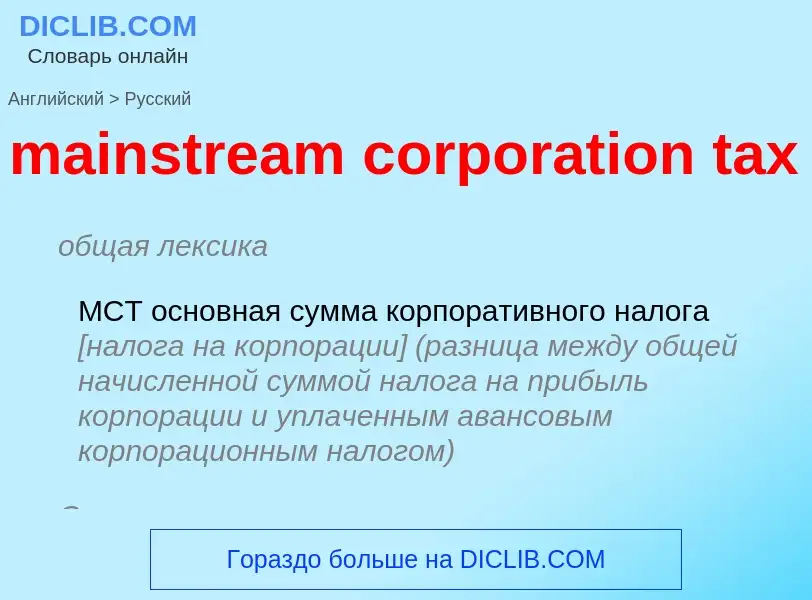Tradução e análise de palavras por inteligência artificial ChatGPT
Nesta página você pode obter uma análise detalhada de uma palavra ou frase, produzida usando a melhor tecnologia de inteligência artificial até o momento:
- como a palavra é usada
- frequência de uso
- é usado com mais frequência na fala oral ou escrita
- opções de tradução de palavras
- exemplos de uso (várias frases com tradução)
- etimologia
mainstream corporation tax - tradução para russo
общая лексика
MCT основная сумма корпоративного налога [налога на корпорации] (разница между общей начисленной суммой налога на прибыль корпорации и уплаченным авансовым корпорационным налогом)
Смотрите также
['meinstri:m]
общая лексика
основное направление, главная линия
прилагательное
['meinstri:m]
общая лексика
конформистский
идущий по прямой
идущий по главному каналу
американизм
представляющий большинство
существительное
['meinstri:m]
общая лексика
река
имеющая притоки
основное направление, главная линия (в искусстве, литературе и т. п.)
американизм
главное течение
основное направление
основная
господствующая тенденция
глагол
американизм
помещать отставших в своём развитии детей вместе с нормальными
Definição
Wikipédia

Ireland's Corporate Tax System is a central component of Ireland's economy. In 2016–17, foreign firms paid 80% of Irish corporate tax, employed 25% of the Irish labour force (paid 50% of Irish salary tax), and created 57% of Irish OECD non-farm value-add. As of 2017, 25 of the top 50 Irish firms were U.S.–controlled businesses, representing 70% of the revenue of the top 50 Irish firms. By 2018, Ireland had received the most U.S. § Corporate tax inversions in history, and Apple was over one–fifth of Irish GDP. Academics rank Ireland as the largest tax haven; larger than the Caribbean tax haven system.
Ireland's "headline" corporation tax rate is 12.5%, however, foreign multinationals pay an aggregate § Effective tax rate (ETR) of 2.2–4.5% on global profits "shifted" to Ireland, via Ireland's global network of bilateral tax treaties. These lower effective tax rates are achieved by a complex set of Irish base erosion and profit shifting ("BEPS") tools which handle the largest BEPS flows in the world (e.g. the Double Irish as used by Google and Facebook, the Single Malt as used by Microsoft and Allergan, and Capital Allowances for Intangible Assets as used by Accenture, and by Apple post Q1 2015).
Ireland's main § Multinational tax schemes use "intellectual property" ("IP") accounting to affect the BEPS movement, which is why almost all foreign multinationals in Ireland are from the industries with substantial IP, namely technology and life sciences.
Ireland's GDP is artificially inflated by BEPS accounting flows. This distortion escalated in Q1 2015 when Apple executed the largest BEPS transaction in history, on-shoring $300 billion of non–U.S. IP to Ireland (resulting in a phenomenon dubbed by some as "leprechaun economics"). In 2017, it forced the Central Bank of Ireland to supplement GDP with an alternative measure, modified gross national income (GNI*), which removes some of the distortions by BEPS tools. Irish GDP was 162% of Irish GNI* in 2017.
Ireland's corporation tax regime is integrated with Ireland's IFSC tax schemes (e.g. Section 110 SPVs and QIAIFs), which give confidential routes out of the Irish corporate tax system to Sink OFC's in Luxembourg. This functionality has made Ireland one of the largest global Conduit OFCs, and the third largest global Shadow Banking OFC.
As a countermeasure to potential exploits by U.S. companies, the U.S. Tax Cuts and Jobs Act of 2017 (TCJA) moves the U.S to a "territorial tax" system. The TJCA's GILTI–FDII–BEAT tax regime has seen U.S. IP–heavy multinationals (e.g. Pfizer), forecast 2019 effective tax rates that are similar to those of prior U.S. tax inversions to Ireland (e.g. Medtronic). Companies taking advantage of Ireland's corporate tax regime are also threatened by the EU's desire to introduce EU–wide anti-BEPS tool regimes (e.g. the 2020 Digital Services Tax, and the CCCTB).



.png?width=200)
.jpg?width=200)
.jpg?width=200)

.png?width=200)

![Apple's Q1 restructuring of IP on Ireland's Balance of Payments.<br />[[Brad Setser]] & Cole Frank (the [[Council on Foreign Relations]])<ref name="taxf"/> Apple's Q1 restructuring of IP on Ireland's Balance of Payments.<br />[[Brad Setser]] & Cole Frank (the [[Council on Foreign Relations]])<ref name="taxf"/>](https://commons.wikimedia.org/wiki/Special:FilePath/Ireland Balance of Payment Components (2012-2017).png?width=200)
![CoFR]]).<ref name="cofr"/> CoFR]]).<ref name="cofr"/>](https://commons.wikimedia.org/wiki/Special:FilePath/Ireland Trade Good Discrepancy (1995-2017).png?width=200)
.png?width=200)
![Revenue]].<ref name="coffey2"/> Revenue]].<ref name="coffey2"/>](https://commons.wikimedia.org/wiki/Special:FilePath/Irish Corporation Tax Rates (1974 to 2016).png?width=200)
.jpg?width=200)




![Shadow Banking OFC]].<ref name="FSF1"/> Shadow Banking OFC]].<ref name="FSF1"/>](https://commons.wikimedia.org/wiki/Special:FilePath/Uncovering Offshore Financial Centers Figure 3 Network of ownership flows between countries.jpg?width=200)
![NBER]]).<ref name="gabrielzucman"/><ref name="zucwright"/> NBER]]).<ref name="gabrielzucman"/><ref name="zucwright"/>](https://commons.wikimedia.org/wiki/Special:FilePath/Where do U.S. multinationals book their profits (2016 BEA).png?width=200)
